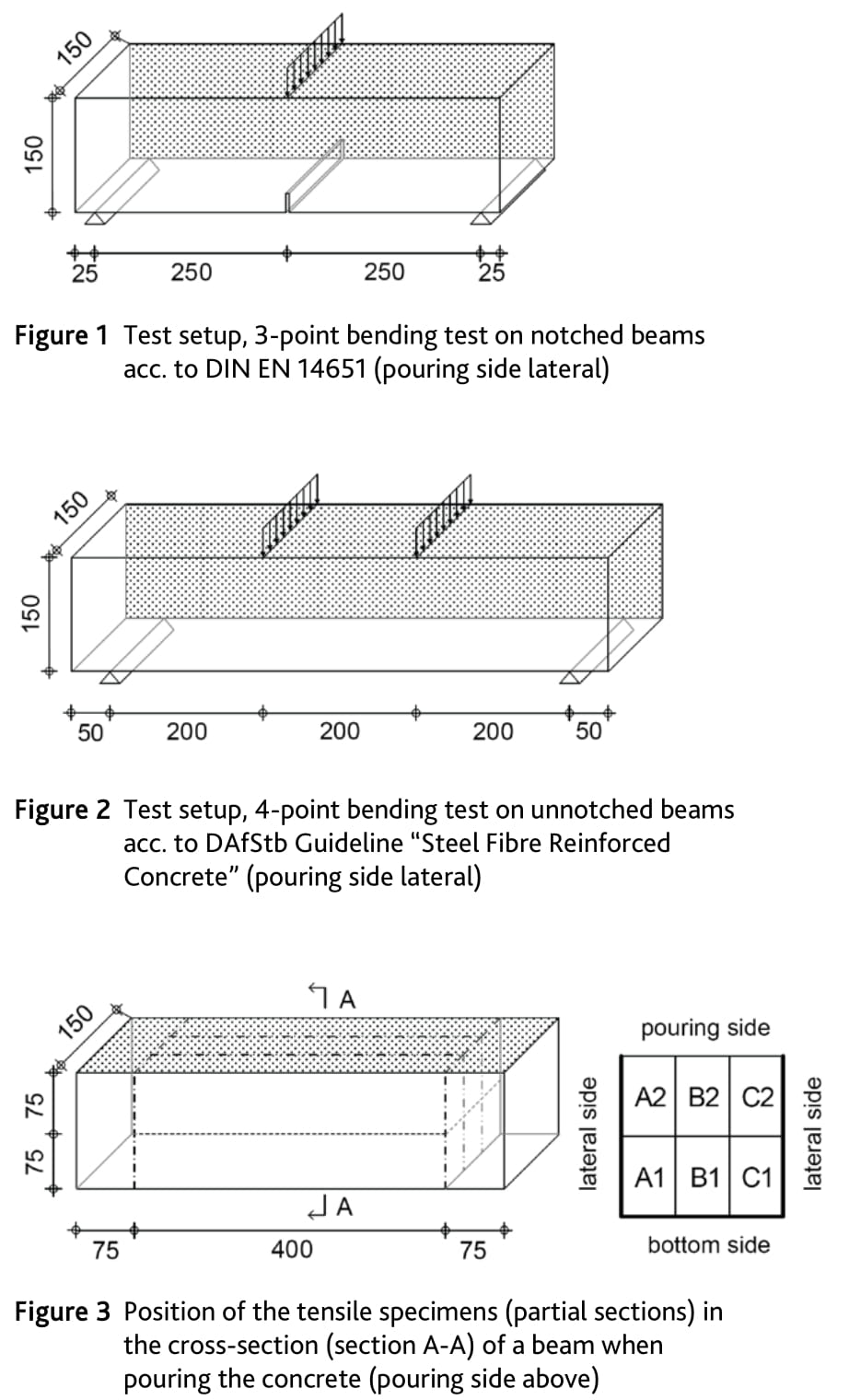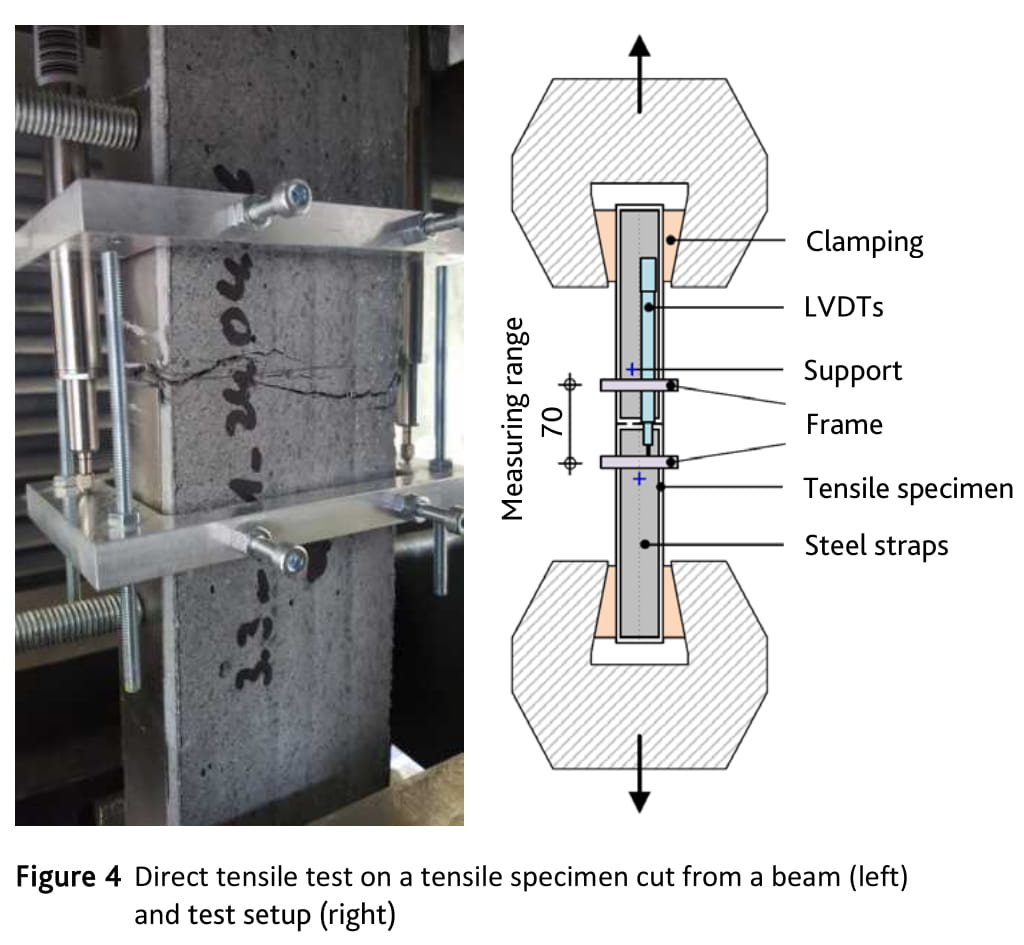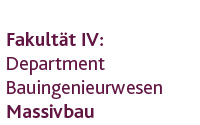.jpg)
Univ.-Prof. Dr.-Ing. Torsten Leutbecher
Raum: PB-A 111/2
 +49 271 740-2592
+49 271 740-2592
 leutbecher@bau.uni-siegen.de
leutbecher@bau.uni-siegen.de
Deriving the post-cracking tensile strength of ultra-high performance steel fibre reinforced concrete from bending tests
Research topic
Design and construction with ultra-high performance concrete (UHPC), Mechanics of fibre reinforced concrete (FRC)
Funding and project duration
German Committee for Structural Concrete (Deutscher Ausschuss für Stahlbeton, DAfStb), Research Project V 497, sub-project A
Duration: February 2017 until January 2018
Person in charge
Jan-Frederik Rebling, M.Sc.
Project description
 As usual for steel fibre reinforced concrete, representative values of the residual tensile strength are used within the current draft of the DAfStb Guideline "Ultra-High Performance Concrete" to characterise the tensile behaviour of ultra-high performance fibre reinforced concrete (UHPFRC). The residual tensile strength is defined as maximum value of the stress-crack opening relationship in the cracked state. This governing strength value should be derivable in the simplest possible way using the residual flexural tensile strength determined by 3-point bending tests.
As usual for steel fibre reinforced concrete, representative values of the residual tensile strength are used within the current draft of the DAfStb Guideline "Ultra-High Performance Concrete" to characterise the tensile behaviour of ultra-high performance fibre reinforced concrete (UHPFRC). The residual tensile strength is defined as maximum value of the stress-crack opening relationship in the cracked state. This governing strength value should be derivable in the simplest possible way using the residual flexural tensile strength determined by 3-point bending tests.
To identify conversion factors for the correlation between the residual tensile strength and the residual flexural tensile strength 7 series with a total of 42 3-point bending tests acc. to DIN EN 14651 (Fig. 1), 12 4-point bending tests acc. to the DAfStb Guideline "Steel Fibre Reinforced Concrete" (Fig. 2) as well as 168 direct tensile tests on bar-shaped tensile specimens (Fig. 3), previously sawn out of beams, were tested. Three different UHPFRC-mixtures with variation of aggregate’s maximum grain size (Dmax = 0.5, 3 and, 8 mm), fibre geometry (lf/df [mm] = 9/0.175 and 17/0.20) and fibre content (0.5, 1.0, and 2.5 % by vol.) were applied within the tests. The concrete consistency was flowable to self-compacting.
The residual flexural tensile strength and the residual tensile strength reach their maximum values in tests with UHPFRC with a fibre content of 2.5 % by vol.. Using the long fibres leads to overall higher strengths than using the short fibres. The test results are also influenced by aggregate’s maximum grain size Dmax. For maximum activation, longer fibres require a larger slip than short fibres. Thus, specimens made with UHPFRC-mixtures including the long fibres showed both the maximum residual tensile strength and the maximum residual flexural tensile strength at a larger deformation than specimens made with UHPFRC-mixtures using the short fibres.
The direct tensile tests on tensile specimens cut from beams (Fig. 4) showed varying mean residual tensile strengths for the different partial sections of a beam cross-section. This was obviously caused by a systematic heterogenic fibre distribution and fibre orientation within a beam cross-section. Tensile specimens taken from the centre of the beams’ surface from which the concrete was poured into the formwork, showed the respectively lowest residual tensile strengths. This is probably caused by the missing of favourably acting casted beam surfaces and the turbulent flow behaviour observed when pouring the viscous fresh concrete into the formwork.
into the formwork, showed the respectively lowest residual tensile strengths. This is probably caused by the missing of favourably acting casted beam surfaces and the turbulent flow behaviour observed when pouring the viscous fresh concrete into the formwork.
By comparing the average residual tensile strength obtained
from the tensile specimens cut from beams and the residual flexural tensile strength (maximum value of the stress-deflection curve), the evaluation of the different UHPFRC-mixtures leads to a wide range of results. On the one hand this is caused by the varying inhomogeneities within the beams’ cross-section depending on which UHPFRC-mixture was used. On the other hand, the axial tensile strength to flexural tensile strength ratio is basically higher for UHPFRC-mixtures with short fibres due to the fact, that beams made with UHPFRC using long fibres show a higher capacity of rotation. They can therefore develop higher bearing capacities in bending due to redistribution of internal forces than beams with shorter fibres even though the concrete mixtures provide the same residual tensile strength. However, the higher bearing capacity with longer fibres is reached at larger midspan deflections.The impact of the fibre length can be compensated by evaluating the residual flexural tensile strength not as the maximum value of the stress-defection curve but for all beams with the same midspan deflection.
With regard to the DAfStb Guidline "Ultra-High Performance Concrete" it is recommended to derive the residual tensile strength based on fib Model Code 2010 from a residual flexural tensile strength determined by 3-point bending tests acc. to DIN EN 14651 for CMOD1 = 0.5 mm respectively δ1 = 0.47 mm. In case that the homogeneity of the residual tensile strength distribution within the beam cross-section is unknown, it is recommended to limit the residual tensile strength simplified to 0.37 times the residual flexural tensile strength determined at a midspan deflection of δ1 = 0.47 mm. 4-point bending tests acc. to the DAfStb Guideline "Steel Fibre Reinforced Concrete" are not recommended due to the disadvantage that the course of the load-deflection curve of unnotched beams is significantly affected by the arbitrary crack formation (multiple cracking for higher fibre contents) and the place of the decisive failure crack.
Publications
LEUTBECHER, T.; RIEDEL, P., 2020. Compressive strength classes and performance classes of ultra-high-performance concrete (Part 2) | Druckfestigkeits- und Leistungsklassen für ultrahochfesten Beton (Teil 2). Betonwerk und Fertigteil-Technik/Concrete Plant and Precast Technology. 86(10), 46-53. ISSN 0373-4331
LEUTBECHER, T.; RIEDEL, P., 2020. Compressive strength classes and performance classes of ultra-high-performance concrete (Part 1) | Druckfestigkeits- und Leistungsklassen für ultrahochfesten Beton (Teil 1). Betonwerk und Fertigteil-Technik/Concrete Plant and Precast Technology. 86(9), 46-54. ISSN 0373-4331
LEUTBECHER, T., 2020. Klassifizierung von ultrahochfestem Beton: Hintergründe und Prüfverfahren. In: Kongressunterlagen 64. BetonTage: Betonbau der Zukunft. Neu-Ulm, 18.-21. Februar 2020. Betonwerk und Fertigteil-Technik/Concrete Plant and Precast Technology. 86(2), 72. ISSN 0373-4331
LEUTBECHER, T.; REBLING, J., 2019. Predicting the postcracking strength of ultra‐high performance fiber reinforced concrete by means of three‐point bending tests according to EN 14651. Structural Concrete. 20(6), 2081-2095. ISSN 1464-4177. doi:10.1002/suco.201900070
LEUTBECHER, T.; REBLING, J., 2018. Experimentelle Untersuchungen zur Ableitung der zentrischen Nachrisszugfestigkeit von UHFB aus Biegeversuchen. Bauingenieur. 93(11), 463-472. ISSN 0005-6650. doi:10.37544/0005-6650-2018-11-81
